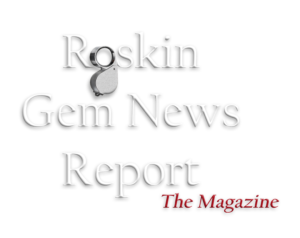The Gemmological Association of Australia (GAA) has taken a giant leap this year with the launch of its Certificate in Opal Studies–its first comprehensive, online course dedicated exclusively to opal.
Far from being a rework of existing material, this is a completely new course built from the ground up, the product of more than six years and hundreds of hours of volunteer effortby the GAA supported by the Australian Opal Centre. As told by the Association, “This course is a world first… and expert-led.”
The GAA Certificate in Opal Studies course opened for enrolments this past February. The program delivers 11 structured modules that take opal enthusiasts from the fundamentals of opal’s structure and how we get play-of-color (POC), through classifications of the different varieties of opals, their localities around the world, the details for cutting, to valuation, ethics, and the realities of the marketplace.
After working through several of the modules, I can say unequivocally that it lives up to the praise it has already received. According to Ken Scarratt, Vice President, World Jewellery Confederation (CIBJO) and Dean of the CIBJO Academy, “The GAA Certificate in Opal Studies provides a titanic amount of opal gemmological knowledge. The program is thoroughly recommended.”
“Titanic.” Yes! Ken is right about that. This course is packed with genuine first-hand knowledge, images, and video, provided by the experts who mine, cut, and sell opal. And it’s a course that is enjoyable to work through. How often do you get to say that?

The GAA’s Certificate in Opal Studies is the first comprehensive online course devoted entirely to opal. Covering 11 structured modules, it takes students from opal’s fundamentals and classification through to cutting, valuation, buying, handling, and ethics.
Highlights include:
- Consistent terminology (Module 2): Aligns with the new CIBJO classification, reducing confusion and protecting consumer confidence.
- Practical bench guidance (Module 8): From rough handling and pre-cut analysis to yield planning and ethical record keeping.
- Real trade insights (Module 9): The journey from mine to market, with frank discussion of buying environments, risks, and presentation.
- Professional ethics (Module 11): Focus on provenance and responsibility in today’s gem market.
- Outstanding Visuals throughout, including videos.
- Even greater knowledge, connecting you to additional resources.
In short, the program is not just academic–it’s a professional resource.

A Structured Journey Into Opal
The course begins with Opal Fundamentals, defining what opal is, how to inspect it, and how composites differ from the natural material. Module 2 is certainly one of the key chapters, teaching us how we Describe and Classify Opal, addressing even one of the most persistent challenges in the jewelry industry: inconsistent terminology.
Modules 3 through 7 extend the context, covering opal formation, opalized fossils, valuation factors, mining practices, and global occurrences. By the time students reach the cutting bench, they have a complete picture of how opal forms, how it is described, and what drives its value.
From Rough to Cut (Module 8)
The technical centerpiece of the course is Module 8: From Rough to Cut. It covers everything from handling and storing rough (including guidance on humidity and storage environments) to pre-cut analysis, yield, and cutting strategies.
Students are taught to weigh the trade-offs between cutting for calibrated sizes (with greater waste) versus freeform cutting (with often better yield and colour play). The module also stresses the importance of record keeping and provenance documentation–including photographs at each stage–to bolster both buyer confidence and ethical practice.
Buying and Selling (Module 9)
Module 9: Buying Opal shifts focus to the market itself. A flow chart maps the journey from mine to market, helping students understand how opal changes hands through miners, lapidaries, wholesalers, retailers, online platforms, and even TV sales channels.
The module is refreshingly honest, warning about marketing ploys like “direct from the miner”, the risks of online marketplaces, and how lighting, background, and presentation can dramatically affect perception of value. It also highlights the strengths of trusted in-person buying, underscoring the importance of both careful inspection and informed questioning.
Beyond the Bench
The final two modules–Handling, Care and Setting (Module 10) and Opal Matters: Business & Ethics (Module 11)–round out the program. Students learn best practices for storing rough and maintaining jewellery set with opal, alongside the broader context of ethical supply chains and corporate social responsibility. By concluding with ethics, the GAA underscores that gemmology today is about more than gemmological or jewelry knowledge–it is about professionalism and transparency.
Final Thoughts
What makes the Certificate in Opal Studies stand out is its holistic design. It isn’t just an opal classification guide, or a trade manual, a cutting course or an evaluation process – it’s all of that and more, seamlessly integrated into a coherent, well-structured program.
We don’t want to forget to mention, the course is 100% online and entirely self-paced.
In our opinion, the GAA has created not just a course, but a model for how specialist gem programs should be built. For students, it’s a guided pathway through the complexity of the world’s most unique gemstone. For professionals, it’s an opportunity to align with the latest international standards in classification, and valuation.
And we highly recommend it!
Tap here to go to the GAA’s Website where you can learn more about the course, and sign up!













